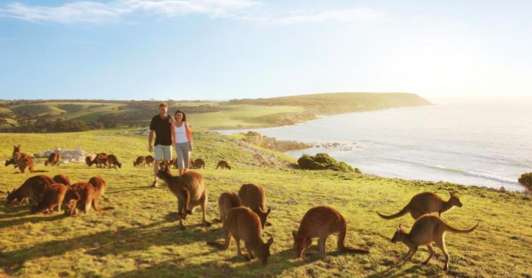
A new study funded by the Australian Renewable Energy Agency will look at the possibility of using renewable energy to provide 100 per cent of the power needs of the iconic Kangaroo Island. But it appears to be a race against time.

The study – led by the Institute of Sustainable Futures at Sydney’s University of Technology – needs to deliver a report by July 15 on the 100 per cent renewable energy option to meet a deadline by the South Australian network operator, SA Power Networks, on future gird options for the island.
As RenewEconomy reported in April, SAPN is looking to replace the ageing cable to the mainland, and issued a tender for “non-network” options. In other words, if another party can provide an alternative that would use local power resources such as wind and solar for less than the cost of the cable – $45-$50 million.
The ISF study is being conducted because the energy experts there are concerned that anyone wanting to put in a proposal for 100 per cent renewable may be discouraged because of the time and effort involved, and the risk that it would not be adopted. So it is looking to combine resources and convince SAPN of the schemes merits.
“Something like this is going to be pretty ambitious,” said ISF project director Chris Dunstan. “It’s not just about a year or two spending deferral, its about a whole new energy paradigm.
Dunstan’s team have already been working on various scenarios, and in a presentation earlier this month at the Electricity Networks Association conference in Adelaide suggested a 100 per cent renewable energy scenario could shave 30 per cent off customer bills.
Dunstan proposed a 8MW wind turbines, 4MW centralised solar PV, and 4MW rooftop PV, with 3MW battery storage, most of it co-located with solar PV. This would be combined with energy efficiency measures and a small diesel plant running at just 3 per cent load factor.
It concluded that the indicative total cost would be around $50 million, the same as the cable but invested on the island. There would be additional operating expenditure of $1.2 million, and annual bill savings to Kangaroo Island customers of around $3 million, or 30 per cent.
Kangaroo Island is currently served by the cable and a back-up 6MW diesel generator at the main town of Kingscote. About one-quarter of the 3,000 homes already have rooftop solar, and there are two larger installations of 14kW at the council chambers and 50kW at the airport (both used to help power the island’s electric vehicles).
Average load is currently around 3.5MW, with a peak load of just under 8MW, but this is forecast to rise to around 13MW by 2030. Kangaroo Island is Australia’s third biggest island (after Tasmania and Melville Island), and has one of the largest island populations with about 4,500 residents and more than 200,000 visitors per year.
“If we can show that renewable energy is technically and economically viable for Kangaroo Island, it would be a powerful precedent for communities around Australia who are seeking to develop their own renewable energy resources,” Dunstan says.
The idea has the support of the local community, keen to tap into the island’s iconic status as a spectacular natural habitat with the added attraction of renewable energy.
“Kangaroo Island has great wind, solar and biomass resources and a strong commitment to environmentally sustainable economic development, said Kangaroo Island Council CEO Andrew Boardman.
“Reliable, renewable energy should be the cornerstone of this development. It is crucial that we invest the time to investigate properly our clean energy options.”
Mayor Peter Clements said the island had been discussing and working in the area of renewable energy and a low carbon future since 2011 and “it is now firmly in the minds of the community.”
ARENA is investing $60,000 into the research project. Acting ARENA CEO Ian Kay said it represented a great opportunity to demonstrate the potential of renewables to generate clean, reliable and cost effective electricity for fringe-of-grid communities like Kangaroo Island.
ISF is interested in hearing from other proponents of non-network options for Kangaroo Island. They are encouraged to contact ISF via: Dr Geoff James, Project Manager – geoff.james@uts.edu.au; tel: (02) 9514 4950.
Giles Parkinson is founder and editor of One Step Off The Grid, and also edits and founded Renew Economy and The Driven. He has been a journalist for 35 years and is a former business and deputy editor of the Australian Financial Review.


